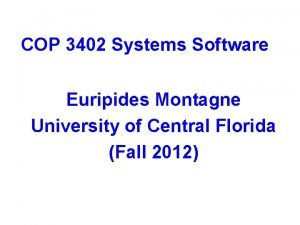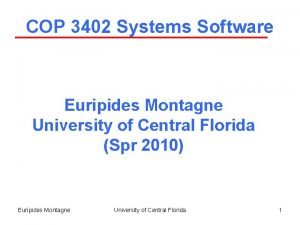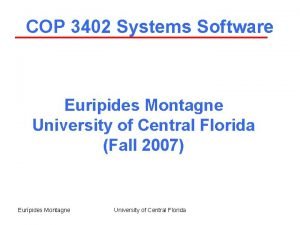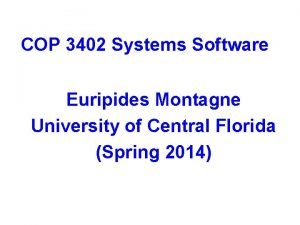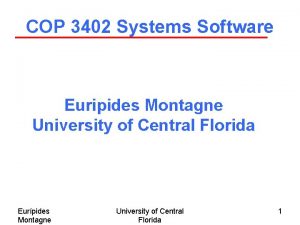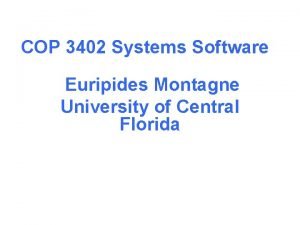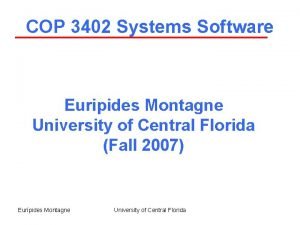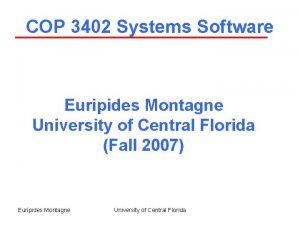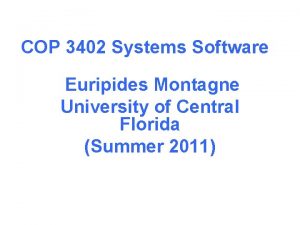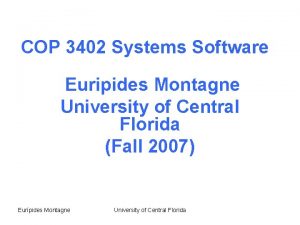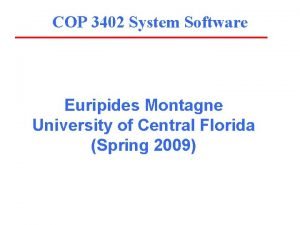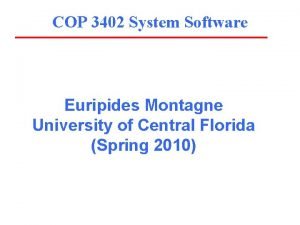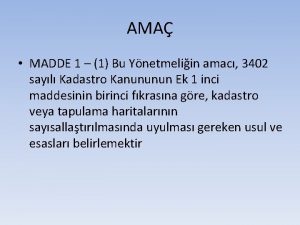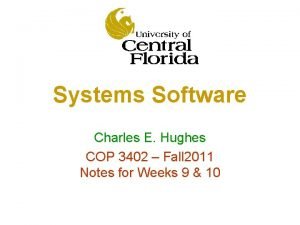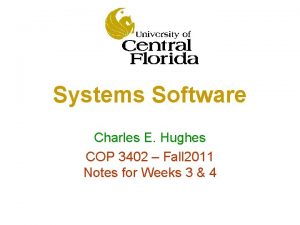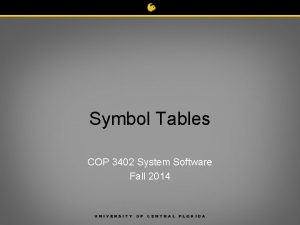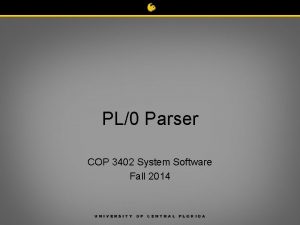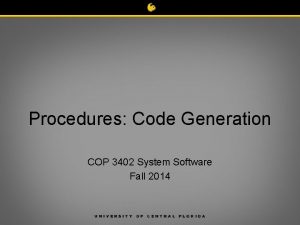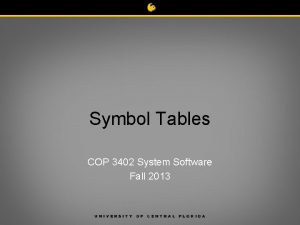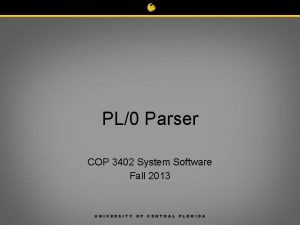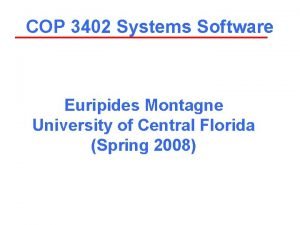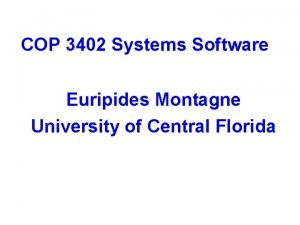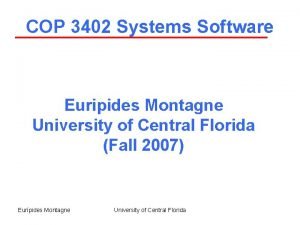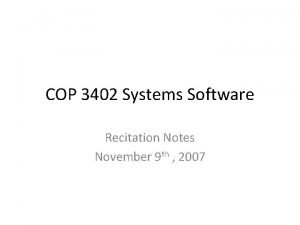Systems Software Charles E Hughes COP 3402 Fall


















- Slides: 18

Systems Software Charles E. Hughes COP 3402 – Fall 2011 Notes for Weeks 11 & 12

Assign#3 Help Days#20

Syntax Directed Translation Days#21, 22

Syntax Directed Defn. (SDD) • A CFG with attributes and rules • Example: – Production – E E 1 + T Semantic Rule E. code = E 1. code || T. code || ‘+’ • In above || is concatenation of strings • The example shows synthesized attributes – ones that flow up the parse tree 10/18/2021 © UCF EECS 4

SDD in Bison • Bison/Yacc has built-in notion of attributes referred to as $$, $1, etc. • In Bison, you can declare type YYSTYPE to override default of int used for yylval • Often one uses a union and the type can be referenced by union type tag $<tag>$ or $<tag>1 etc. • If you do not set $$ then default is $$ = $1 10/18/2021 © UCF EECS 5

Attributes • Attributes are synthesized when they are defined at a node labeled A using attributes of the node and its children. • Attributes are inherited when they are defined at node labeled A using attributes of the node, its parent and its children (also typically allows younger siblings to pass along values to older ones. ) • Terminals are only allowed to have synthesized attributes. 10/18/2021 © UCF EECS 6

S- and L-sttributed • An SDD with only synthesized attributes is called Sattributed. S-attributed are often used for bottom-up where they can be evaluated on the fly. • An SDD with mixed synthesized and inherited attributes is called L-attributed if it can be evaluated left-to-right and usually pre-order. L-attributed are often used for topdown. • Under certain circumstances (the right kind of dependencies) both types can be evaluated in one pass. 10/18/2021 © UCF EECS 7

S-attributed <E> <E 1> + <T> <E> <E 1> – <T> <E> <T> <T 1> * <F> <T> <T 1> / <F> <T> <F> – <F 1> <F> ( <E> ) <F> id <F> unsigned_integer 10/18/2021 E. val : = E 1. val + T. val {$$=$1+$3; } E. val : = E 1. val – T. val {$$ = $1 -$3; } E. val : = T. val {$$ = $1; } T. val : = T 1. val * F. val {$$ = $1*$3; } T. val : = T 1. val / F. val {$$ = $1/$3; } T. val : = F. val {$$ = $1; } F. val : = – F 1. val {$$ = -$1; } F. val : = E. val {$$ = $2; } F. val : = id. entry {$$ = $1. entry; } F. val : = unsigned_integer. val {$$=$1; } © UCF EECS 8

Annotated Parse Tree • Adds attributes to nodes • Also called attributed or decorated • S-attributed evaluates up the tree (typically postorder traversal but any bottom-up works) • L-attributed evaluates pre-order and left to right. The pre-order allows attributes to flow from parent; left-to-right allows younger children to pass values along. 10/18/2021 © UCF EECS 9

S-attributed Evaluation • (1+3)*2 10/18/2021 © UCF EECS 10

L-attributed <E> <T> <TT> + <T> <TT 1> <TT> – <T> <TT 1> <TT> e <T> <F> <FT> * <F> <FT 1> <FT> / <F> <FT 1> <FT> e <F> – <F 1> <F> ( <E> ) <F> id <F> unsigned_integer TT. inh : = T. val; E. val : = TT. syn TT 1. inh : = TT. inh + T. val; TT. syn : = TT 1. syn TT 1. inh : = TT. inh – T. val; TT. syn : = TT 1. syn TT. syn : = TT. inh FT. inh : = T. val; E. val : = FT. syn FT 1. inh : = FT. inh F. val; FT. syn : = FT 1. syn FT 1. inh : = FT. inh / F. val; FT. syn : = FT 1. syn FT. syn : = FT. inh F. val : = – F 1. val F. val : = E. val F. val : = id. entry F. val : = unsigned_integer. val Note: inherited attribute of a node can be assigned to synthesized attribute but not vice versa. 10/18/2021 © UCF EECS 11

L-attributed Evaluation • (1+3)*2 (yellow is syn or val; blue is inh) 10/18/2021 © UCF EECS 12

Declaration Statements <D> <T> <L> <T> int <T> float <L> <L 1> ‘, ’ id <L> id 10/18/2021 L. inh : = T. type : = integer T. type : = float L 1. inh : = L. inh; add. Type(id. entry, L. inh) © UCF EECS 13

Evaluation Order • Any order that maintains dependencies is acceptable in attribute evaluation • Typical approach is topological sort of dependency graph • Problem: If actions have side effects then one must be careful to not change semantics with varying orders of evaluation 10/18/2021 © UCF EECS 14

S-synthesizing a Syntax Tree <E> <E 1> + <T> <E> <E 1> – <T> <E> <T> <T 1> * <F> <T> <T 1> / <F> <T> <F> – <F 1> <F> ( <E> ) <F> id <F> num 10/18/2021 E. node : = new Node(‘+’, E 1. node, E. node) E. node : = new Node(‘–’, E 1. node, E. node) E. node : = T. node : = new Node(‘*’, T 1. node, F. node) T. node : = new Node(‘/’, T 1. node, F. node) T. node : = F. node : = new Unary. Node(minus, F 1. node) F. Node : = E. node F. node : = new Leaf. Node(ident, id. entry) F. node : = new Leaf. Node(number, num. val) © UCF EECS 15

L-synthesizing a Syntax tree <E> <T> <TT> + <T> <TT 1> <TT> – <T> <TT 1> <TT> e <T> <F> <FT> * <F> <FT 1> <FT> / <F> <FT 1> <FT> e <F> – <F 1> <F> ( <E> ) <F> id <F> num 10/18/2021 E. node : = TT. syn; TT. inh : = T. node TT 1. inh : = new Node(‘+’, TT. inh, T. node; TT. syn : = TT 1. syn TT 1. inh : = new Node(‘–’, TT. inh, T. node; TT. syn : = TT 1. syn TT. syn : = TT. inh T. node : = FT. syn; FT. inh : = F. node FT 1. inh : = new Node(‘ ’, FT. inh, F. node; FT. syn : = FT 1. syn TT 1. inh : = new Node(‘/’, TT. inh, F. node; FT. syn : = FT 1. syn FT. syn : = FT. inh F. val : = – F 1. val F. node : = E. node F. node : = new Leaf. Node(ident, id. entry) F. node : = new Leaf. Node(number, num. val) © UCF EECS 16

Flattening of the Syntax Tree • Triples and quads as we defined them are a form of flattening • Triples are compact but hard to move • Quads are wasteful in many cases, but easy to move, e. g. , from inside a loop to precede it when semantics are still correct 10/18/2021 © UCF EECS 17

Indirect Triples • Compromise between triples and quads • Generate triples but have a separate list that specifies which triples actually are at a particular node position 10/18/2021 © UCF EECS 18
 Euripides montagne
Euripides montagne Euripides montagne
Euripides montagne Cop 3402
Cop 3402 Euripides montagne
Euripides montagne Euripides montagne
Euripides montagne Cop 3402
Cop 3402 Euripides montagne
Euripides montagne Cop 3402
Cop 3402 Cop 3402
Cop 3402 Euripides montagne
Euripides montagne Euripides montagne
Euripides montagne Euripides montagne
Euripides montagne Good cop bad cop interrogation
Good cop bad cop interrogation Cop 1 cop 2
Cop 1 cop 2 Mark hughes jill hughes
Mark hughes jill hughes Isae 3402 type b
Isae 3402 type b 3402 1 madde
3402 1 madde Charles manson childhood
Charles manson childhood Refrigerant cop
Refrigerant cop
